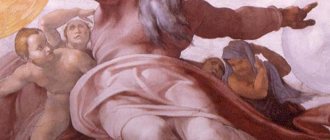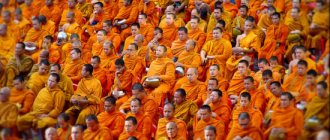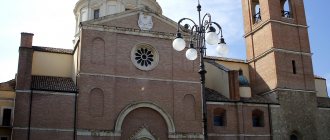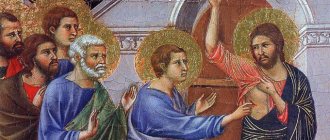Whether God exists or not has been debated for hundreds of years. Believers diligently argue their views, while skeptics just as diligently refute them. In this article we will touch upon 5 proofs of the existence of God by Thomas Aquinas. We will also look at examples of refutation in order to clearly understand the strengths and weaknesses of this system.
About the proofs of Saint Thomas
Saint Thomas Aquinas is a famous Catholic theologian, whose works have acquired the status of the official creed of the Western Church, led by the Papal See in Rome. The mentioned 5 proofs of the existence of God by Thomas Aquinas were set out by him in a fundamental work called “Summa Theology”. In it, the author, among other things, argued that the existence of the Creator can be proven in two ways, namely with the help of cause and with the help of effect. In other words, we are talking about arguments from cause to effect and from effect to cause. Thomas Aquinas's five proofs for the existence of God are based on the second approach. Their general logic is as follows: since there are obvious consequences of the cause, then the cause itself also takes place. Thomas argues that the existence of God is not obvious to people. Therefore, its existence can be proven if we consider the Creator as the root cause of the consequences obvious to us. This statement is taken as a basis by St. Thomas Aquinas. 5 proofs of the existence of God, briefly described, of course, will not allow us to fully appreciate the depth of thought of this outstanding theologian, but they will quite help to form a general impression of the problem raised.
Belt of Thomas Aquinas
There is a legend that one day, during a meal in the monastery, Thomas Aquinas heard a voice saying to him: “Here in the monastery everyone is fed, but in Italy my flock is starving.” Thomas decided that it was time for him to leave the monastery.
Thomas's family opposed his decision to be Dominican. His brothers even resorted to meanness in order to deprive Thomas of chastity. The saint began to pray, and he had a vision. The angel girded him with a belt as a symbol of the eternal chastity that God had granted him. The belt is kept to this day in the convent of Scieri in Piedmont.
According to legend, the Lord asked Saint Thomas at the end of his life what reward he would like to receive for his labors. Thomas replied: “Only You, Lord!”
Proof one. From the movement
In modern times, this argument from Thomas is usually called the kinetic argument. It is based on the assertion that everything that exists is in motion. But nothing can move by itself. For example, a cart is moved by a horse, a car is driven by a motor, and a sailboat is driven by a flow of air. Molecules, atoms and everything that is in the world move, and all of it receives an impulse to action from the outside, from something else. And then, in turn, from the third and so on. The result is an endless chain of causes and effects. But an endless chain, as Thomas claims, cannot exist, otherwise there would be no first engine. And since there is no first, then there is no second, and then movement would not exist at all. Accordingly, there must be a primary source, which is the cause of the movement of everything else, but which itself is not susceptible to the influence of third forces. This prime mover is God.
Perfection is a subjective concept
Also noteworthy is the 4th proof of the existence of God, put forward by Thomas Aquinas, which talks about a certain gradation of perfection in the existing world. In this regard, many critics ask the question of how, for example, beauty can be measured, and by what criteria to measure aesthetic feelings. It is well known that yesterday’s standards of beauty are often perceived today as examples of mediocrity. Thus, our experience of beauty is full of subjectivity.
Proof two. From the producing cause
This argument is based on the assertion that every thing, every phenomenon is a consequence of some producing cause. A tree, according to him, grows from a seed, a living being is born from a mother, glass comes from sand, and so on. Moreover, no thing in the world can be the cause of itself, since in this case it would be necessary to admit that it existed before its appearance. In other words, an egg cannot lay itself, and a house cannot build itself. And as a result, we again get a chain of endless causes and consequences, which must end at the original source. His existence is not the effect of a prior cause, but he himself is the cause of everything else. And if it were not there at all, then there would be no process of producing causes and effects. This primary source is God.
Classic Proofs for the Existence of God
In the tradition of proofs of the existence of God, the most famous are the five proofs of the existence of God or the “five ways” of Thomas Aquinas (1225-1274): 1. “From motion to the Prime Mover.” 2. “From the connection of causes and effects - to the First Cause.” 3. “From chance – to a Necessary Being.” 4. “From imperfections in the world to Absolute perfection.” 5. “From expediency in the world - to the Organizer of the world.”
Proof one: Movement occurs in nature. Nothing can start moving on its own; it requires an external source of action. An endless search for the source of the previous action is pointless. Therefore, there must be something that is the original source of all movement, not being itself moved by anything else. This is God - the immovable Mover.
Proof two, cosmological: Every effect has its own cause. An endless search for a previous cause is pointless. Therefore, there must be an “uncaused cause,” the first cause of everything that follows. This is God.
Proof three: All objects of the world are interconnected and interrelated with each other, and their existence is possible only in interconnection and interrelation. However, an endless search for antecedent relationships and interconnections is pointless. Therefore, there must be something absolutely independent and completely self-sufficient. This is God.
Proof four, ontological: In the surrounding world there is a consistent hierarchical increase in the complexity of the structure of objects and creatures (for example, from insects to humans), an endless universal desire for perfection. Therefore, there must be something absolutely perfect, which is the source of all perfection. This is God.
Fifth proof, teleological: In the surrounding world there is a certain order and harmony, the origin of which cannot be attributed to the world itself. This order forces us to assume the existence of some intelligent organizing principle that established this order. This is God.
These five proofs of the existence of God by Thomas Aquinas are traditionally used by Catholic theologians as confirmation of the fact of His existence. Over the centuries, proofs of the existence of God were formulated not only by theologians such as Thomas Aquinas, Anselm of Canterbury, Malebranche, etc., but also by philosophers - Plato, Aristotle, Descartes, Leibniz, etc.
Thus, the German philosopher Immanuel Kant (1724-1804) was the first to reduce all such evidence from a purely philosophical position to three main ones: ontological, cosmological and teleological. Although Kant later showed the inconsistency of the proofs put forward by himself, he was forced to create a fourth - moral (moral) proof of the existence of God.
Since then, these four proofs of Kant have been called “classical” proofs of the existence of God (the existence of God). And it is precisely this system of Kant’s four “classical” proofs that is usually used in Orthodox and Protestant theologies to prove the existence of God.
Of course, the five proofs of the existence of God by F. Aquinas or the four proofs of the existence of God by I. Kant today are not the “highest” product of the philosophical thought of mankind. Many centuries have passed since these five proofs were formulated, and in all centuries philosophers, theologians and scholastics have had constant debates on this matter. The rapid development of natural history and science in the Renaissance contributed to the emergence and development of new ways of proving God. New important scientific discoveries of the 20th century also made a significant contribution to the questions of a thinking person’s knowledge of the nature of the Universe and the fact of the existence of its First Cause.
Naturally, today there are much more such ways of proving the existence of God than the classical four or five. An attempt to summarize these various philosophical and scientific ways of proving the existence of God was made by Georgy Khlebnikov, candidate of philosophical sciences, in his article “16 proofs of the existence of God” in the journal “Thomas” No. 2 (8) 1999.
FROM THE EDITOR. Today, many believers and non-believers alike agree that it is impossible to rationally prove the existence of God. True, for various reasons. If the former believe that this is impossible, since God reveals himself to the purity of the heart, and not to the intricacies of the mind, then the latter are convinced that since it is impossible to scientifically testify to the fact of the existence of God, then there is no God, because only science is objective.
However, not everyone knows that in Christian culture there is a centuries-old tradition of proving the existence of God. In the Middle Ages, such evidence became popular thanks to Catholic scholastic theologians, primarily Anselm of Canterbury and Thomas Aquinas.
True, the scholastics, as a rule, did not address their arguments to atheists - what atheists were in the Middle Ages! – and to believers, in order to confirm faith in a rational way. Since the existence of God seemed obvious, “reasonable,” then in the world, in life, philosophers sought to find obvious, reasonable confirmation of this.
It is interesting to note that in the Orthodox tradition no such school of “proofs of the existence of God” arose. Orthodoxy proceeded and proceeds from a different understanding of the relationship between faith and reason (although neither Orthodox nor Catholics, as a rule, oppose reason and faith). The main proof in Orthodoxy was and remains the person himself, who met God in his heart. And if this meeting did not happen, how can you believe? And if it happened, then a loving heart no longer needs any more arguments!
But many of us were trained in Western philosophy. And our thinking itself has acquired such a Western “flavor”. How many times have we heard: prove, rationally justify that God exists! And if, by and large, such evidence is unlikely to lead a person to God (this is the editorial position), this does not mean that they are absolutely useless. After all, for some they can become the first step on the path to faith...
Today we do not live in medieval Byzantium or Rus', but also not in medieval Western Europe. Much water has passed under the bridge since then, but the believing mind has never ceased to inquisitively seek the rational foundations of its faith, finding new and new evidence of the presence of the Creator in the world.
The following article is an attempt to list and (to begin with) a brief description of searches in this area.
16 EVIDENCE OF THE EXISTENCE OF GOD
1. The first proof, which can be called “existential” (that is, “proof from existence”), is formulated as follows: Why is everything that exists more likely to exist than not?
After all, both creating something and maintaining the existence of anything is much more difficult than having nothing at all. Try, for example, to design a cottage yourself, choose a suitable place for it, build and constantly maintain order in it... Or, for example, for your vegetable garden to really be a vegetable garden, it needs to be regularly dug up, planted, weeded, watered, etc. If this is not done, the garden will immediately become overgrown with weeds, go wild and turn into an ordinary field without any trace of reasonable care.
In other words, the existence of any thing or structure requires a continuous expenditure of energy; when its internal supply is depleted or its influx from the outside stops, the structure collapses. Therefore, the eternal existence of the Universe contradicts, for example, the second law of thermodynamics, according to which all the stars in the Universe should have gone out long ago and even the atoms should have disintegrated if, as atheistic materialists claim, nature had existed forever.
So why does it still exist as being, as a beautiful and wonderful Cosmos? Undoubtedly, only because it was created by Someone and has been supported by Him since then.
This Creator is God, about whom Sir Isaac Newton (1642-1727), who formulated the laws of universal gravitation and motion and discovered differential calculus, said: “He abides forever; present everywhere; It constitutes the duration of time and space.”
2. The second proof is as follows: why does everything that exists, is naturally and amazingly ordered, bear the undoubted imprint of a reasonable plan for the structure of the whole? After all, such a plan cannot but presuppose the existence of a Mind that is superhuman in its capabilities, a truly divine Planner (since regularity is a property of the mind)?
Thus, Nicolaus Copernicus (1473-1543), who created the theory that the Sun is at the center of the universe, and the Earth only revolves around it, believed that this model demonstrates the wisdom of God in the universe, for “who else could place this lamp ( Sun) to a different or better position?
When a watchmaker assembles a watch mechanism, he meticulously fits one part to another, takes a spring of precisely calculated length, a certain size of hand, dial, etc. The result is a wonderful mechanism, which, by the very fact of the expediency and calculation of its design, indicates the mind that created it.
But how much more complex, harmonious and intelligent is the structure of the entire Universe surrounding us, this beautiful Cosmos!
Albert Einstein (1879-1955), who formulated the theory of relativity, expressed this idea this way: “The harmony of natural law reveals a Mind so superior to us that in comparison with it all systematic thinking and action of human beings is an extremely insignificant imitation.”
The Universe, as the ancient Greeks said, is a “Cosmos,” that is, a beautifully ordered and harmonious complex system consisting of interconnected parts, each of which is subject to special laws, and all of them as a whole are governed by a combination of general laws, so that the pursuit of any particular goal contributes in an amazing way to achieving the overall goal of the whole.
Therefore, it is impossible to allow all this to be a matter of chance, and not of reasonable Providence, that is, the Providence of God.
3. The “cosmological proof” of the existence of God was developed by the ancients (in particular, Aristotle) and is most often found in the following form: every thing in the world and everything, the entire Universe as a whole has a reason for its existence, but continue this sequence, the chain of reasons until infinity is impossible - somewhere there must be a First Cause, which is no longer determined by any other, otherwise everything turns out to be groundless, “hanging in the air.”
Not only philosophers, but also many naturalists and scientists speak about such a Cause. Thus, the famous Louis Pasteur (1822-1895), who, by the way, developed the world-famous milk purification process, which has since bear his name, often mentioned the “cosmic asymmetrical Force” that created life. He believed that the concept of cause "should be reserved for the single divine impulse which formed this Universe."
It is clear that such an uncaused cause is God: “God is not a man” - He is spiritual (“ideal”, like a thought), that is, he is outside of time and space, therefore he does not arise, but exists forever, being not a cause in the physical meaning of the word , but the Creator of the visible Universe and its laws.
4. The “anthropic principle of the Universe” as proof of the existence of an intelligent plan for the structure of the Universe and God was, probably unwittingly, put forward by modern science, which suddenly found out that life on Earth, the emergence of man and the development of civilization are possible only in the presence and combination of extremely rigid and paradoxically unlikely conditions that seem to be inherent in nature itself: a fixed distance from the Sun (a little closer to it and living organisms would burn, a little further and they would freeze, turning into insensitive blocks of ice); the presence of the Earth's rotation, without which unbearable heat would reign on one half of the planet, while the other would be bound by eternal ice; the existence of a satellite of a certain size that provides a complex system of circulation of water flows; minerals and resources : coal, metals, oil, water, etc., without which technogenic civilization could not arise and develop, etc.
Moreover, modern scientists have the impression that the entire Universe is located and oriented in such a way that it can be viewed with human eyes! The existing coordination, interconnectedness and interdependence of these factors is such that the possibility of its “accidental” occurrence is completely excluded.
5. The following proof of the creation of the Cosmos by intelligent will was also formulated at the forefront of modern cosmology and physics, which drew attention to the paradoxical nature of the existence of the Universe in the form in which it exists: it turned out that only according to the four main basic physical constants, without which it could not to exist for a long time as a structurally organized whole, the probability of their “random” occurrence and coordination with each other is approximately 10 to the minus 100th power.
But there are not four basic constants, but much more...
6. The following “ teleological” (from the Greek “telos” - fulfillment, result) proof of the existence of God has been known in general form since antiquity, when Aristotle first noticed the presence of clearly expressed expediencies in the body of some animals and in nature. However, only modern discoveries in biology have indisputably proven the systemic nature of these teleological mechanisms and their necessity for the existence and survival of almost all types of living beings.
A type of activity of these mechanisms is, for example, the “pre-established harmony” of the development of various living organisms, which, even in the embryonic state, seem to know in advance what they will have to face after birth.
And, which Darwinian evolutionary theory is completely unable to explain, studies of fossil organisms have shown that many of them have organs that anticipate external environmental conditions by millennia, organs that are absolutely useless in the current conditions of existence of these animals, but will really be needed by this species in hundreds of generations, when the conditions of existence will radically change!
A legitimate question arises, to which modern evolutionary theory has no answer: how can a body devoid of intelligence have such amazing pre-knowledge of future changes and how can it itself cause the required favorable mutations in itself?!
This amazing fact clearly indicates the presence in the world of a certain and reasonable development program, that is, Providence, which is called the Providence of God.
7. The “transcendental” proof of the existence of the ideal world and God was partly discovered by Kant and can be presented as follows: there is a world outside of space and time - the spiritual world, the world of intellect, thought and free will - which is proven by the presence of thoughts in every person, which can relate to the past and future, that is, “travel” to the past and future, and also be instantly transported to any point in space.
Each of us, turning our consciousness to the source of the origin of our thoughts, can easily notice that they appear as if from somewhere outside, the thought turns out to be a spiritual ray projected from somewhere, which illuminates material existence like a sunbeam - it is of no use to anyone. and you never manage to cover it with your hand, it always ends up on top...
Thus, human thought, supposedly born in the brain, turns out to be simultaneously inside and outside matter - it supposedly arises due to neurophysiological processes in the tissues of the brain, surrounded by the bones of the skull, but, at the same time, fundamentally exists outside of any matter, outside of space and time.
Thanks to this, a person clearly realizes that he has a spiritual nature, which is fundamentally different from the physical world that surrounds him. But it follows from this that this other nature, this Spirit, the manifestation of which is man, also has reason and free will - like man himself.
8. The next proof could probably be called “creationist” - it is based on the fact of the existence in nature of organisms and living systems that, in principle, cannot develop into such a whole from parts by evolutionary means, as Darwinism believes, but can only be created together, as just such an organic whole.
These, for example, may include the interconnected system of the heart, lungs and blood circulation in living beings: it is impossible to imagine that first, let’s say, only blood circulation without a heart appeared, then the heart gradually “attached” to it and began to pump blood, and only after that The lungs have just begun to develop.
9. Proof of the existence of God and the spiritual world from personal experience - most people have encountered in their lives “strange” manifestations of the divine and superhuman: both beneficial, Divine, and malicious, demonic, or, probably most often, both together.
In order not to touch upon the dubious “legends of deep antiquity” for many, I will tell you about an incident that happened to my colleague. He came from a believing family, but at one time he taught “scientific atheism” at a university for many years and, like most Soviet intellectuals, led a far from pious lifestyle. After experiencing several personal tragedies, he realized the depravity of his life and decided to go to the temple.
When the priest, he told me, read a prayer for forgiveness of sins over my head, and I began to get to my feet, some unknown force suddenly began to throw me from side to side so that I could not stand on my feet: the parishioners supported me on both sides, my knees were shaking and, to top it all off, I was suddenly overcome by a strange weakness. So for the first time I felt for myself the demons that are in a sinner,” he concluded.
Quite a lot of similar examples could be given.
10. Proof of the existence among all nations and peoples of ideas about God and superhuman powers in one form or another; Although atheistic individuals are found among many nations, there are no “atheistic” nations on Earth.
11. Proof of the faith in God of most of the outstanding geniuses of mankind. For example, the absolute majority of Nobel laureates.
It should also be remembered that all the scientists who contributed with their discoveries to the emergence and development of modern science (Copernicus, Kepler, Newton, Boyle, Bacon, Pasteur, Einstein) believed in God.
Thus, the founder of modern chemistry, Robert Boyle (1627-1691), began every day with prayer; Moreover, 2/3 of the income from his estate in Ireland went to helping the poor and supporting the Church, and 1/3 to spreading Christianity and missionary work among the Indians.
Francis Collins, one of the founders of genetics, said: “When we learn something new about the human genome, I always feel a sense of awe that humanity now knows something that only God knew before. I don't believe that scientific research can threaten God in any way. On the contrary, I think God benefits from our curiosity.”
12. Undoubted proof of the existence of God is also the regular appearance in the history of mankind of great saints and religious figures who directly have spiritual revelations from above and thereby testify to His existence.
These are not only prophets such as Moses, Isaiah, Ezekiel, who constantly communicated with God, but also righteous people who illuminated and directed the lives of people at all times with their light.
Perhaps it will be enough to simply remind the reader of such great Russian saints as Seraphim of Sarov or John of Kronstadt in order to understand that God turns to us now as often as in distant biblical times - if only we had eyes to see, and ears to hear.
God is always with us. It is we, due to our weakness, that either move away or try to return to Him again.
13. Proof by contradiction: the tragic fate of projects (and, often, their own lives and fates) of outstanding atheists. The most striking example here may be the example of the “Lenin-Stalin case” and their followers, who for the first time in history tried to build an atheistic state on a “scientific basis” both on the territory of Russia and other countries of Europe and Asia.
For example, the fate of the best materialist philosopher of the USSR, Evald Vasilyevich Ilyenkov, the son of the famous Soviet writer, laureate of the Stalin Prize for Literature, turned out to be tragic. All his life, justifying the atheistic thesis about the “self-development of matter,” which does not need any spiritual foundation for its existence, Evald Vasilyevich could not find moral support anywhere in Soviet atheistic reality, fell into deep depression and committed suicide...
14. The “ethical proof” of the existence of the supersensible world, which comes from the objective existence of morality and ethical laws governing the behavior of human beings, is also widely known.
Research by many philosophers indicates that events and environmental influences can only to a certain extent predetermine the behavior of people and force them to certain actions: no matter how strong the external pressure, a person always has the opportunity to break the cause-and-effect relationship, which irrational nature submits and act as a free being, that is, as a being of another, unearthly world!
To illustrate this, a simple example can be given: why do some people give alms and others not? It would seem that the latter act quite logically and reasonably - why part with your funds, money, knowing that you will not receive any compensation?!
So what forces the former to give alms, sometimes even in significant amounts? There is nothing in the physical world, in nature, that could explain such “illogical” behavior - this explanation lies outside of this, in the supersensible world, where the great moral ideas of love, goodness and mercy are located.
The famous reasoning of Immanuel Kant, who clearly showed that man in his actions and actions is guided by values that do not belong to the material world, also belongs to this type of evidence of the existence of God.
15. The proof of the existence of God called the “aesthetic argument” has also become widespread, which says: in nature there is an amazing supernatural beauty of the starry sky, sunsets and sunrises, the Northern Lights, harmonious pictures of nature, the perfect structure of the beautiful bodies of living beings, etc. , which seems to be specially intended for the aesthetic pleasure of a rational being - man - because besides him in nature itself there is simply no one to contemplate it.
Robert Boyle, already mentioned, was so in awe of the beauty of nature that he often said: “When I study the book of nature... I am often forced to exclaim with the psalmist: Oh, how manifold are Thy works, O Lord, in Thy wisdom Thou hast made them all!”
16. The proof of the existence of God “from real to absolute perfection” was put forward by Thomas Aquinas: in nature there is a clearly observable gradation of perfection within various types of being, which can only be understood in the presence of an absolutely perfect Being, that is, God.
This proof may seem quite complicated at first, but a simple example will help to understand its essence: if you have a ruler, say, 30 centimeters long, and your colleague has a ruler 50 cm long, if there are rolled meters and other means of measurement, then all this exists only because the dimension of space (its extension in different directions) and the idea of length actually exist.
In the same way, similar examples could be given with measures of weight, time, etc. But in nature there are also more complex types of gradations, among which a unique place belongs to the “ascending ladder” of perfection both in inanimate and living nature, and in human society, as well as among people themselves: there are, for example, crooked and ugly trees, There are ordinary, unremarkable ones, there are “simply” beautiful ones, but there are also unusually beautiful, perfect specimens. And so not only among different types of trees, but also among different breeds of fish, animals, within human races, etc. – more and less perfect individuals can be found everywhere. But these different degrees of perfection in inanimate nature (for example, among stones!), between individual types of objects, living beings, etc., could not exist if for them there was no really existing measure of absolute perfection, which, however, we do not find in the material world, but which cannot but exist, and this perfection is God! This is the essence of this proof.
Thus, we see that no matter where and how we begin to consider the world around a person, all roads inevitably lead to the One who created and adorned him, Who constantly supports and guides him, and without Whom he could not exist even for a moment - to God.
THIS IS INTERESTING: From the theory of evolution to a new theory of creation - the errors of Darwinism and a proposal from the point of view of the Unification Philosophy
Proof three. From necessity and chance
Like all 5 proofs of the existence of God of Thomas Aquinas, this argument is based on the law of cause and effect. However, it is very unique. Thomas argues that there are contingent things in the world that may or may not exist. Once upon a time they really existed, but before that they did not exist. And it is impossible to imagine, according to Thomas, that they arose by themselves. Accordingly, there must be a reason for their appearance. Ultimately, this leads us to postulate the existence of an entity that would be necessary in itself and would have no external reasons for being necessary for all others. Thomas defines this essence with the concept “God”.
Problems with the first, second and fifth arguments
The first two arguments are, in principle, very similar, so they can be considered together. In fact, this proof was invented by Aristotle. It is very simple and boils down to the fact that there cannot be an infinite series of causality and there must be some first cause of everything.
There is a common objection to this argument, coined, coincidentally, by Aristotle's contemporary, the Indian philosopher Nagarjuna. He believed that God must either be the same phenomenon as all other phenomena in the world, or not be one. If he is the same phenomenon as all others, then he must also have his own beginning and he must also be created by something. If he is not the same phenomenon, then he simply does not exist and he did not create the world, just as the son of a childless woman cannot plow the land. Or God had to create himself. However, this is impossible, just as it is impossible for a sword to cut its own blade or for a dancer to dance on his own shoulders.
Golden sculpture of Nagarjuna
There is one more claim to the hypothesis that if the world has a beginning, then something must have started it, and this beginning must be God. It is that it is completely unclear why the hypothesis that the creator of the universe is God should be preferable to the hypothesis that it was spontaneously generated. The emergence of a perfect omnipotent being who created the world seems more absurd than the random spontaneous generation of this world. By adding God into the mix, we are just taking a step back from the first cause, without explaining why anything came to be in the first place. Moreover, this step is given to us at the cost of unnecessary complication of the entire theory. Ultimately, even if we agree that the world must have a beginning, it is completely unclear why an omnipotent and omniscient God should be recognized as this beginning, and not the Big Bang or something else.
The German philosopher Immanuel Kant, who we already mentioned in our conversation about ontological proof, calls such proofs physical and theological. In his opinion, their problem is that they are trying, on the basis of experience alone, to go beyond the limits of this experience and to deduce the existence of a being that cannot be given in experience.
The only justification for these two arguments could be contained in the fifth argument: the world is too intelligently designed to be an accident. However, those who use this argument confuse cause and effect. It is not the world that is intelligently arranged, but the human mind that is adjusted to the world. After all, he arose within the framework of this world and its laws, he did not meet other worlds. So this is the only world he knows. And this world can be comprehended by the mind only insofar as the mind is intended to comprehend the world. There is no expediency of the creator’s highest plan here. It’s just that something that would not correspond to this world could not exist in it, and it does not exist in it.
Proof four. From the degree of perfection
Thomas Aquinas based 5 proofs of the existence of God on Aristotelian formal logic. One of them says that in all things that exist in the world, various degrees of perfection appear. This refers to the concepts of goodness, beauty, nobility and form of existence. However, degrees of perfection are known to us only in comparison with something else. In other words, they are relative. Aquinas further concludes that, against the background of all relative things, a certain phenomenon must stand out, endowed with perfection to an absolute degree. For example, you can compare things by beauty either in relation to the worst or in relation to the best things. But there must be an absolute criterion, beyond which nothing can be. This most perfect phenomenon in all respects is what is called God.
As Thomas Aquinas said
Loving someone is the same as wishing that person well.
We must truly love others for their own good, not ours.
Knowledge is such a valuable thing that there is no shame in obtaining it from any source.
What you don’t want to have tomorrow, discard today, and what you want to have tomorrow, acquire today.
Our duty is to hate the sin of the sinner, but to love the sinner himself because he is a person capable of good.
A person should not consider his wealth as his own, but he should treat it as a common property so that he can distribute it without hesitation among those who need help.
A happy person needs friends not in order to benefit from them, for he himself succeeds, and not in order to admire them, for he possesses the perfect delights of a virtuous life, but, in fact, in order to do good deeds for these friends.
Proof five. From leading the world
Like all 5 proofs of the existence of God by Thomas Aquinas, this starts from the idea of a first cause. In this case, it is considered in the aspect of meaningfulness and purposefulness that the world and the living creatures inhabiting it possess. The latter strive for something better, that is, consciously or unconsciously pursue some goal. For example, procreation, a comfortable existence, and so on. Therefore, Thomas concludes that there must be a supreme being who intelligently controls the world and creates his own goals for everything. Of course, this being can only be God.
Alternative theories of world creation
All the above statements of the famous Italian not only do not reveal the secret of the foundations of the universe, but also emphasize our complete ignorance of this issue. In this regard, numerous theories have recently become widespread, the authors of which are trying to answer it. Hypotheses are put forward that attribute the creation of our world to some extraterrestrial civilization or consider it as the result of the action of some natural, but unknown to science, laws of nature.
Thus, today the root cause of the appearance of all things is sometimes presented in the most incredible concepts, and God the Creator becomes just one of the many answers to the questions once formulated by Thomas Aquinas.
Kant's 6th proof. Kant's proofs
In the 13th century, Bishop Thomas Aquinas of the Roman Catholic Church felt discomfort. A lot of people appeared around the church who, reading the holy books, began to THINK. And they came up with the idea of denying God. Although they, the heretics, were told more than once: believe, do not reason - this is still inaccessible to the human mind.
In the 13th century, Bishop Thomas Aquinas of the Roman Catholic Church felt discomfort. A lot of people appeared around the church who, reading the holy books, began to THINK. And they came up with the idea of denying God. Although they, the heretics, were told more than once: believe, do not reason - this is still inaccessible to the human mind. But neither fires nor torture could stop these stubborn people from thinking logically and... finding inconsistencies. Not to realize once and for all that “nature ends in grace, reason in faith, and all philosophical knowledge in supernatural revelation.” 15 years before the birth of Thomas, Aristotle's Aesthetics was burned. But Bishop Thomas Aquinas loved Aristotle very much. Like any bishop, he did not favor the heretics of his day. And he came up with a brilliant move - to fight the heretics with their own weapons. He decided to prove the existence of God using... the principles of the materialist Aristotle. To reason about the existence of God, to prove His existence as a theorem. And one of the most paradoxical teachings in the history of civilization arose. Aquinas established five attributes of God. Let me briefly remind you (without quoting). The first sign is through movement. Since every movement has something that moves, then there must be a Prime Mover. The second is causal. Every phenomenon has a cause, which means that all phenomena must have a First Cause. Third, everything that exists by chance may or may not exist. Therefore, there must be a Regulator. The fourth is quality. Since there are various forms of Perfection, Beauty, Goodness, then there must be absolute Perfection, Goodness and Beauty. Fifth - expediency. Everything rational and unreasonable in the world is directed towards expediency. This means there must be a Leader. Half a thousand years after Aquinas, Immanuel Kant crossed out all five signs of God, arguing that in the realm of reason there is no and cannot be evidence of the existence of God. And then (as Bulgakov recalled in the novel “The Master and Margarita”) Kant established the sixth. Here it is: “Moral principles do not depend on the external environment.” “The moral law is compulsion, the need to act contrary to empirical influences. This means that it takes the form of a coercive command—an imperative.” To put it quite simply, it would sound like this: a person acts not only in connection with simple necessity. Some aspects of human behavior are not subject to ordinary logic. In this case, the proof of the existence of God is art and culture. And the only proof. Art shows that a person commits actions that are not related to simple survival and the simple logic of Existence. Beethoven's symphonies and Raphael's paintings are not necessary in the cycle of human survival. It is their existence and the existence of those who enjoy them that proves the existence of a Supreme Power. And indeed! Has it ever occurred to you that art has no path from simple to complex? Bach is no simpler than Shostakovich (while the mathematics and physics of Bach's time are simpler than the mathematics and physics of Shostakovich's time). Cave painting is no simpler than Picasso's painting. You can start studying the history of art not from the beginning, but from the end. Art is always at its best (no matter what pits humanity finds itself in). There is no number in mathematics that cannot be increased ten, a hundred or more times. There are no relative values in art. Bach's three-minute chorale prelude is equal in spiritual significance to his three-hour St. Matthew Passion. It is by communicating with art, comprehending it, that we approach the formula of God, the formula of immortality. That is why I, in full agreement with Kant, suggest that every normal person do everything to truly enter the world of art. For it is in this world that we communicate with Divine energy.










